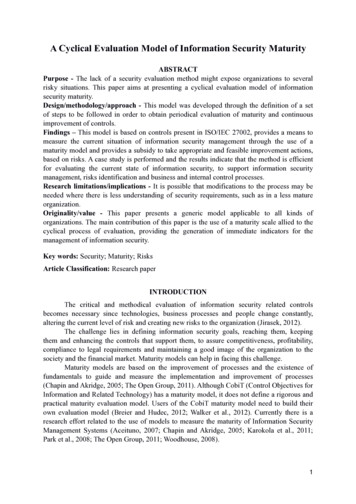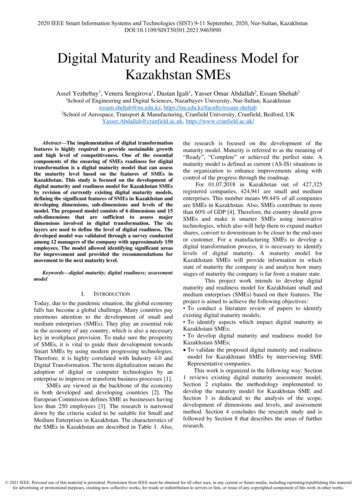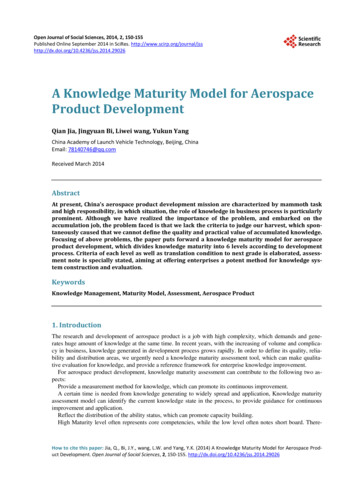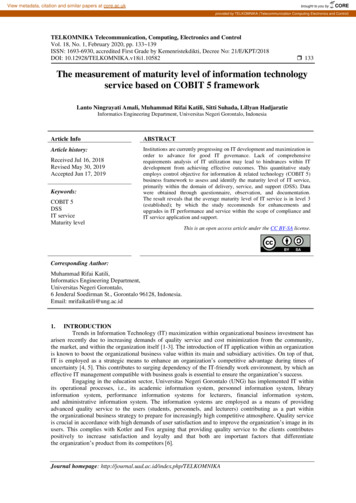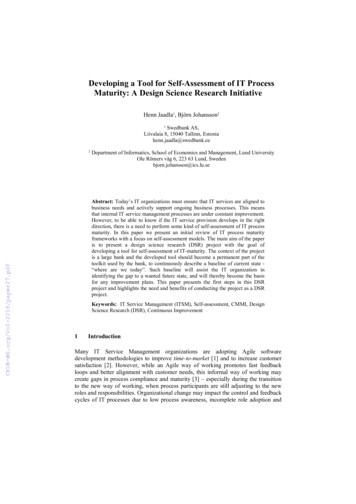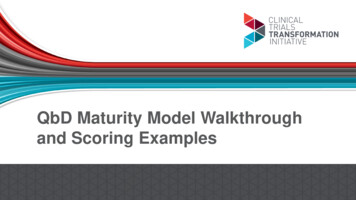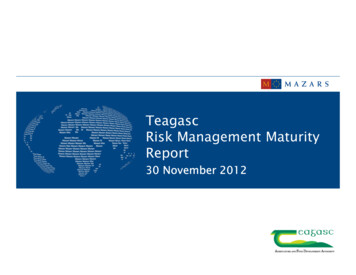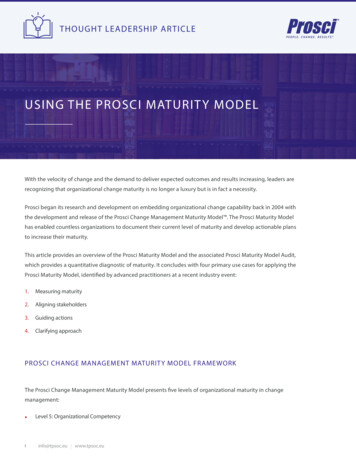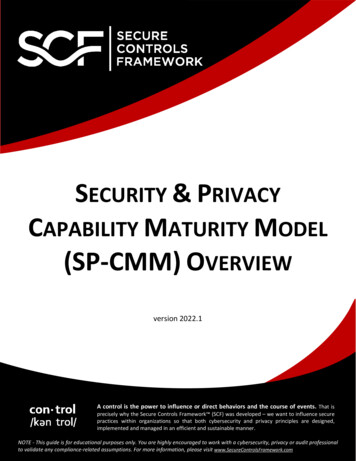
Transcription
SECURITY & PRIVACYCAPABILITY MATURITY MODEL(SP-CMM) OVERVIEWversion 2022.1A control is the power to influence or direct behaviors and the course of events. That isprecisely why the Secure Controls Framework (SCF) was developed – we want to influence securepractices within organizations so that both cybersecurity and privacy principles are designed,implemented and managed in an efficient and sustainable manner.NOTE - This guide is for educational purposes only. You are highly encouraged to work with a cybersecurity, privacy or audit professionalto validate any compliance-related assumptions. For more information, please visit www.SecureControlsFramework.com
Table of ContentsExecutive Summary . 3Objectives of the SP-CMM . 3Not Just Another CMM . 3Nested Approach To Maturity . 3Security & Privacy Capability Maturity Model (SP-CMM) Overview . 4CMM 0 – Not Performed . 4CMM 1 – Performed Informally . 4CMM 2 – Planned & Tracked . 5CMM 3 – Well-Defined . 5CMM 4 – Quantitatively Controlled . 6CMM 5 – Continuously Improving . 6Defining A Capability Maturity “Sweet Spot” . 7Negligence Considerations . 7Risk Considerations . 7Process Review Lag Considerations . 7Stakeholder Value Considerations . 7Analog Example – Sit / Crawl / Walk / Run / Sprint / Hurdle . 8Expected SP-CMM Use Cases . 9Use Case #1 – Objective Criteria To Build A Cybersecurity & Privacy Program . 9Identifying The Problem . 9Considerations . 9Identifying A Solution . 10Use Case #2 – Assist Project Teams To Appropriately Plan & Budget Secure Practices . 12Identifying The Problem . 12Considerations . 12Identifying A Solution . 12Use Case #3 – Provide Objective Criteria To Evaluate Third-Party Service Provider Security . 13Identifying The Problem . 13Considerations . 13Identifying A Solution . 132 of 13 2022. Secure Controls Framework Council, LLC. All Rights Reserved.This guide is for educational purposes only. You are encouraged to work with a cybersecurity, privacy or audit professional to validate any compliance-related assumptions.
EXECUTIVE SUMMARYThank you for showing interest in the Secure Controls Framework’s (SCF) Security & Privacy Capability Maturity Model (SP-CMM)!This was a massive undertaking by SCF contributors to define maturity levels for the SCF’s control catalog. The result of that work is eachof the SCF’s controls has corresponding CMM 0-5 criteria defined.This document is designed for cybersecurity & privacy practitioners to gain an understanding of what the SP-CMM is and how it can beused in their organization.Just like the SCF itself, the SP-CMM is free for organizations to use through the Creative Commons Attribution-NoDerivatives 4.0International (CC BY-ND 4.0) license.OBJECTIVES OF THE SP-CMMThe SP-CMM is meant to solve the problem of objectivity in both establishing and evaluating cybersecurity and privacy controls. Thereare three main objectives for the SP-CMM:1. Provide CISO/CPOs/CIOs with objective criteria that can be used to establish expectations for a cybersecurity & privacy program;2. Provide objective criteria for project teams so that secure practices are appropriately planned and budgeted for; and3. Provide minimum criteria that can be used to evaluate third-party service provider controls.There are likely many other use cases that the SP-CMM can be used, but those three objectives listed above drove the development ofthis project. The reason for this simply comes down to a need by businesses, regardless of size or industry, for a solution that can helpfix those three common frustrations that exist in most cybersecurity and privacy programs. We want to help eliminate, or at leastminimize, the Fear, Uncertainty & Doubt (FUD) that is used to justify purchases and/or evaluate controls by injecting objectivity into theprocess.NOT JUST ANOTHER CMMThere are many competing models that exist to demonstrate maturity. Given the available choices, the SCF decided to leverage anexisting framework, rather than reinvent the wheel. In simple terms, we provided control-level criteria to an existing CMM model.The SP-CMM draws upon the high-level structure of the Systems Security Engineering Capability Maturity Model v2.0 (SSE-CMM), sincewe felt it was the best model to demonstrate varying levels of maturity for people, processes and technology at a control level. If youare unfamiliar with the SSE-CMM, it is well-worth your time to read through the SSE-CMM Model Description Document that is hostedby the US Defense Technical Information Center (DTIC).The SSE-CMM has been around for over two decades and is a community-owned maturity model, so it is free to use. The SSE-CMM isalso referenced as ISO/IEC 21827:2008 Information technology -- Security techniques -- Systems Security Engineering -- CapabilityMaturity Model (SSE-CMM). 1NESTED APPROACH TO MATURITYBy using the term “nested” regarding maturity, we are referring how the SP-CMM’s control criteria were written to acknowledge thateach succeeding level of maturity is built upon its predecessor. Essentially, you cannot run without first learning how to walk. Likewise,you cannot walk without first learning how to crawl. This approach to defining cybersecurity & privacy control maturity is how the SPCMM is structured.1ISO/IEC 21827:2008 - https://www.iso.org/standard/44716.html3 of 13 2022. Secure Controls Framework Council, LLC. All Rights Reserved.This guide is for educational purposes only. You are encouraged to work with a cybersecurity, privacy or audit professional to validate any compliance-related assumptions.
SECURITY & PRIVACY CAPABILITY MATURITY MODEL (SP-CMM) OVERVIEWThe SP-CMM draws upon the high-level structure of the Systems Security Engineering Capability Maturity Model v2.0 (SSE-CMM), sincewe felt it was the best model to demonstrate varying levels of maturity for people, processes and technology at a control level. If youare unfamiliar with the SSE-CMM, it is well-worth your time to read through the SSE-CMM Model Description Document that is hostedby the US Defense Technical Information Center (DTIC).The six SP-CMM levels are: CMM 0 – Not Performed CMM 1 – Performed Informally CMM 2 – Planned & Tracked CMM 3 – Well-Defined CMM 4 – Quantitatively Controlled CMM 5 – Continuously ImprovingCMM 0 – NOT PERFORMEDThis level of maturity is defined as “non-existence practices,” where the control is not being performed. There are no identifiable work products of the process.CMM 0 practices, or a lack thereof, are generally considered to be negligent. The reason for this is if a control is reasonably-expected toexist, by not performing the control that would be negligent behavior. The need for the control could be due to a law, regulation orcontractual obligation (e.g., client contract or industry association requirement).CMM 1 – PERFORMED INFORMALLYThis level of maturity is defined as “ad hoc practices,” where the control is being performed, but lacks completeness & consistency. Base practices of the process area are generally performed. The performance of these base practices may not be rigorously planned and tracked. Performance depends on individual knowledge and effort. There are identifiable work products for the process.CMM 1 practices are generally considered to be negligent. The reason for this is if a control is reasonably-expected to exist, by onlyimplementing ad-hoc practices in performing the control that could be considered negligent behavior. The need for the control could bedue to a law, regulation or contractual obligation (e.g., client contract or industry association requirement).4 of 13 2022. Secure Controls Framework Council, LLC. All Rights Reserved.This guide is for educational purposes only. You are encouraged to work with a cybersecurity, privacy or audit professional to validate any compliance-related assumptions.
Note – The reality with a CMM 1 level of maturity is often: For smaller organizations, the IT support role only focuses on “break / fix” work or the outsourced IT provider has a limited scopein its support contract. For medium / large organizations, there is IT staff but there is no management focus to spend time on the control.CMM 2 – PLANNED & TRACKEDThis level of maturity is defined as “requirements-driven practices,” where the expectations for controls are known (e.g., statutory,regulatory or contractual compliance obligations) and practices are tailored to meet those specific requirements. Performance of the base practices in the process area is planned and tracked. Performance according to specified procedures is verified. Work products conform to specified standards and requirements.CMM 2 practices are generally considered to be “audit ready” with an acceptable level of evidence to demonstrate due diligence anddue care in the execution of the control. CMM 2 practices are generally targeted on specific systems, networks, applications or processesthat require the control to be performed for a compliance need (e.g., PCI DSS, HIPAA, NIST 800-171, etc.).It can be argued that CMM 2 practices focus more on compliance over security. The reason for this is the scoping of CMM 2 practices arenarrowly-focused and are not organization-wide.Note – The reality with a CMM 2 level of maturity is often: For smaller organizations:o IT staff have clear requirements to meet applicable compliance obligations or the outsourced IT provider is properlyscoped in its support contract to address applicable compliance obligations.o It is unlikely that there is a dedicated cybersecurity role and at best it is an additional duty for existing personnel. For medium / large organizations:o IT staff have clear requirements to meet applicable compliance obligations.o There is most likely a dedicated cybersecurity role or a small cybersecurity team.CMM 3 – WELL-DEFINEDThis level of maturity is defined as “enterprise-wide standardization,” where the practices are well-defined and standardized across theorganization. Base practices are performed according to a well-defined process using approved, tailored versions of standard, documentedprocesses. Process is planned and managed using an organization-wide, standardized process.CMM 3 practices are generally considered to be “audit ready” with an acceptable level of evidence to demonstrate due diligence anddue care in the execution of the control. Unlike CMM 2 practices that are narrowly focused, CMM 3 practices are standardized acrossthe organization.It can be argued that CMM 3 practices focus on security over compliance, where compliance is a natural byproduct of those securepractices. These are well-defined and properly-scoped practices that span the organization, regardless of the department or geographicconsiderations.Note – The reality with a CMM 3 level of maturity is often: For smaller organizations:o There is a small IT staff that has clear requirements to meet applicable compliance obligations.o There is a very competent leader (e.g., security manager / director) with solid cybersecurity experience who has theauthority to direct resources to enact secure practices across the organization. For medium / large organizations:o IT staff have clear requirements to implement standardized cybersecurity & privacy principles across the enterprise.o In addition to the existence of a dedicated cybersecurity team, there are specialists (e.g., engineers, SOC analysts, GRC,privacy, etc.)o There is a very competent leader (e.g., CISO) with solid cybersecurity experience who has the authority to directresources to enact secure practices across the organization.5 of 13 2022. Secure Controls Framework Council, LLC. All Rights Reserved.This guide is for educational purposes only. You are encouraged to work with a cybersecurity, privacy or audit professional to validate any compliance-related assumptions.
CMM 4 – QUANTITATIVELY CONTROLLEDThis level of maturity is defined as “metrics-driven practices,” where in addition to being well-defined and standardized practices acrossthe organization, there are detailed metrics to enable governance oversight. Detailed measures of performance are collected and analyzed. This leads to a quantitative understanding of process capabilityand an improved ability to predict performance. Performance is objectively managed, and the quality of work products is quantitatively known.CMM 4 practices are generally considered to be “audit ready” with an acceptable level of evidence to demonstrate due diligence anddue care in the execution of the control, as well as detailed metrics enable an objective oversight function. Metrics may be daily, weekly,monthly, quarterly, etc.Note – The reality with a CMM 4 level of maturity is often: For smaller organizations, it is unrealistic to attain this level of maturity. For medium / large organizations:o IT staff have clear requirements to implement standardized cybersecurity & privacy principles across the enterprise.o In addition to the existence of a dedicated cybersecurity team, there are specialists (e.g., engineers, SOC analysts, GRC,privacy, etc.)o There is a very competent leader (e.g., CISO) with solid cybersecurity experience who has the authority to directresources to enact secure practices across the organization.o Business stakeholders are made aware of the status of the cybersecurity and privacy program (e.g., quarterly businessreviews to the CIO/CEO/board of directors). This situational awareness is made possible through detailed metrics.CMM 5 – CONTINUOUSLY IMPROVINGThis level of maturity is defined as “world-class practices,” where the practices are not only well-defined and standardized across theorganization, as well as having detailed metrics, but the process is continuously improving. Quantitative performance goals (targets) for process effectiveness and efficiency are established, based on the business goalsof the organization. Continuous process improvement against these goals is enabled by quantitative feedback from performing the definedprocesses and from piloting innovative ideas and technologies.CMM 5 practices are generally considered to be “audit ready” with an acceptable level of evidence to demonstrate due diligence anddue care in the execution of the control and incorporates a capability to continuously improve the process. Interestingly, this is whereArtificial Intelligence (AI) and Machine Learning (ML) would exist, since AI/ML would focus on evaluating performance and makingcontinuous adjustments to improve the process. However, AI/ML are not requirements to be CMM 5.Note – The reality with a CMM 5 level of maturity is often: For smaller organizations, it is unrealistic to attain this level of maturity. For medium-sized organizations, it is unrealistic to attain this level of maturity. For large organizations:o IT staff have clear requirements to implement standardized cybersecurity & privacy principles across the enterprise.o In addition to the existence of a dedicated cybersecurity team, there are specialists (e.g., engineers, SOC analysts, GRC,privacy, etc.)o There is a very competent leader (e.g., CISO) with solid cybersecurity experience who has the authority to directresources to enact secure practices across the organization.o Business stakeholders are made aware of the status of the cybersecurity and privacy program (e.g., quarterly businessreviews to the CIO/CEO/board of directors). This situational awareness is made possible through detailed metrics.o The organization has a very aggressive business model that requires not only IT, but its cybersecurity and privacypractices, to be innovative to the point of leading the industry in how its products and services are designed, built ordelivered.o The organization invests heavily into developing AI/ML technologies to made near real-time process improvements tosupport the goal of being an industry leader.6 of 13 2022. Secure Controls Framework Council, LLC. All Rights Reserved.This guide is for educational purposes only. You are encouraged to work with a cybersecurity, privacy or audit professional to validate any compliance-related assumptions.
DEFINING A CAPABILITY MATURITY “SWEET SPOT”For most organizations, the “sweet spot” for maturity targets is between CMM 2 and 4 levels. What defines the ideal target within thiszone is generally based on resource limitations and other business constraints, so it goes beyond just the cybersecurity and privacy teamsdictating targets. Identifying maturity targets is meant to be a team effort between both technologists and business stakeholders.From a business consideration, the increase in cost and complexity will always require cybersecurity and privacy leadership to provide acompelling business case to support any maturity planning needs. Speaking in terms the business can understand is vitally important.Note - During the development of the SP-CMM, a contributor identified an interesting insight that CMM 0-3 are “internal” maturity levelsfor cybersecurity and privacy teams, whereas CMM 4-5 are “external” maturity levels that expand beyond those teams. When you lookat the stakeholders involved in CMM 0-3, it is almost entirely IT, cybersecurity and privacy. It isn’t until CMM 4-5 where there is truebusiness stakeholder involvement in oversight and process improvement. This creates an internal to external shift in owning thecybersecurity & privacy program.NEGLIGENCE CONSIDERATIONSWithout the ability to demonstrate evidence of both due care and due diligence, an organization may be found negligent. In practicalterms, the “negligence threshold” is between CMM 1 and CMM 2. The reason for this is at CMM 2, practices are formalized to the pointthat documented evidence exists to demonstrate reasonable steps were taken to operate a control.RISK CONSIDERATIONSRisk associated with the control in question decreases with maturity, but noticeable risk reductions are harder to attain above CMM 3.Oversight and process automation can decrease risk, but generally not as noticeably as steps taken to attain CMM 3.PROCESS REVIEW LAG CONSIDERATIONSProcess improvements increase with maturity, based on shorter review cycles and increased process oversight. What might have beenan annual review cycle to evaluate and tweak a process can be near real-time with Artificial Intelligence (AI) and Machine Learning (ML).STAKEHOLDER VALUE CONSIDERATIONSThe perceived value of security controls increases with maturity. However, perceived value tends to decrease after CMM 3 since thevalue of the additional cost and complexity becomes harder to justify to business stakeholders. Companies that are genuinely focusedon being industry leaders are ideal candidates for CMM 5 targets to support their aggressive business model needs.7 of 13 2022. Secure Controls Framework Council, LLC. All Rights Reserved.This guide is for educational purposes only. You are encouraged to work with a cybersecurity, privacy or audit professional to validate any compliance-related assumptions.
ANALOG EXAMPLE – SIT / CRAWL / WALK / RUN / SPRINT / HURDLEThe following example shows this approach being applied to the maturity levels for running, where it demonstrates the nested approachto the maturity levels by each succeeding level of maturity incorporates skills learned by the preceding level.The point of this example is to demonstrate a relatable scenario that readers can comprehend how being asked to jump straight into anadvanced level of maturity is not practical, where it requires some level of lesser maturity. For example, if you were just learning how towalk, it would be foolish to try and run the 400m hurdles that require both the strength and skill of sprinting, but also the knowledge ofhow to jump over an obstacle.In this example, this maturity model is applied to a control to raise an individual’s resting heart rate through exercise. CMM 0 – Sitting Downo Sitting down would be non-existent effort. No evidence of exercise exists.o Sitting down would be considered deficient in terms of meeting this control. CMM 1 – Crawlingo Crawling is at best considered ad-hoc exercise and likely doesn’t meet the intent of the control.o Crawling would be considered deficient in terms of meeting this control. CMM 2 – Walkingo Walking builds on skills learned through crawling and demonstrates a capability that raises the individuals’ resting heartrate.o Walking would meet the intent of the control, but there is clearly room for improvement. CMM 3 – Runningo Running builds on the skills learned through walking and meets the control’s intent.o Running would be the “sweet spot” of maturity for this example. CMM 4 – 400-meter Sprinto Sprinting builds on the skills learned through running and meets the control’s intent.o Sprinting requires mastery of running skills to do it properly and avoid injury. CMM 5 – 400-meter Hurdleso Running the hurdles builds upon skills learned through sprinting and meets the control’s intent.o Hurdling requires a mastery of sprinting, since jumping hurdles is in addition to a sprinting race.8 of 13 2022. Secure Controls Framework Council, LLC. All Rights Reserved.This guide is for educational purposes only. You are encouraged to work with a cybersecurity, privacy or audit professional to validate any compliance-related assumptions.
EXPECTED SP-CMM USE CASESUSE CASE #1 – OBJECTIVE CRITERIA TO BUILD A CYBERSECURITY & PRIVACY PROGRAMIdentifying a target maturity state is intended to support your organization’s mission and strategy so without first understanding thebroader mission of the organization and having prioritized objectives, a CISO/CIO/CPO will be guessing when it comes to establishingexpectations for capability maturity. Like anything in life, if you fail to plan you plan to fail - CMM rollouts are no exception.The time to execute a business plan to mature a cybersecurity and privacy program generally spans several years, where certaincapabilities are prioritized over other capabilities. This means the CISO/CIO/CPO will establish CMM targets that evolve each year, basedon prioritization. In the graphic below, the use of a spider chart can be beneficial to identify current vs future gaps with the SP-CMM.Prioritization of capability maturities may be based on risk assessments, audits, compliance obligations or management direction.IDENTIFYING THE PROBLEMUsing a CMM helps organizations avoid “moving targets” for expectations. Maturity goals define “what right looks like” in terms of therequired people, processes and technology that are expected to exist in order to execute controls at the individual contributor level.Without maturity goals, it is very difficult and subjective to define success for a security & privacy program.All too often, unprincipled cybersecurity & privacy leaders manipulate the business through Fear, Uncertainty and Doubt (FUD) to scareother technology and business leaders into supporting cybersecurity initiatives. These bad actors maintain the illusion of a strongcybersecurity & privacy program, when in reality the department is an array of disjointed capabilities that lacks a unifying plan. Theseindividuals stay in the job long enough to claim small victories, implement some cool technology, and then jump ship for larger roles inother organizations to extend their path of disorder. In these cases, a common theme is the lack of viable business planning beyond ashopping list of technologies and headcount targets to further their career goals.CONSIDERATIONSCybersecurity & privacy departments are a cost center, not a revenue-generating business function. That means cybersecurity & privacycompete with all other departments for budget, and it necessitates a compelling business case to justify needed technology and staffing.Business leaders are getting smarter on the topic of cybersecurity & privacy, so these leaders need to rise above the FUD mentality anddeliver value that is commensurate with the needs of the business.9 of 13 2022. Secure Controls Framework Council, LLC. All Rights Reserved.This guide is for educational purposes only. You are encouraged to work with a cybersecurity, privacy or audit professional to validate any compliance-related assumptions.
When identifying a target level of maturity, it is crucial to account for your organization’s culture. The reason for this is theimplementation of perceived “draconian” levels of security can cause a revolt in organizations not accustomed to heavy restrictions. Onegood rule of thumb when deciding between CMM 3 and CMM 4 targets is this simple question: “Do you want to be in an environmentthat is in control or do you want to be in a controlled environment?” CMM 3 maturity is generally considered “an environment that isin control” where it is well-managed, whereas being in a CMM 4 environment is more of a “controlled environment” that is morecontrolled and less free. Given those considerations, environments not used to heavy restrictions may want to target CMM 3 as thehighest-level of maturity targets. Additionally, the cost to mature from a CMM 3-4 or CMM 4-5 could be hundreds of thousands tomillions of dollars, so there is a very real cost associated with picking a target maturity level. This is again where having managementsupport is crucial to success, since this is ultimately a management decision.From a CISO/CIO/CPO perspective, identifying a target level of maturity is also very beneficial in obtaining budget and protectin
we felt it was the best model to demonstrate varying levels of maturity for people, processes and technology at a control level. If you are unfamiliar with the SSE-CMM, it is well-worth your time to read through the SSE-CMM Model Description Document that is hosted by the US Defense Technical Information Center (DTIC).
